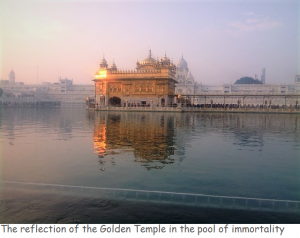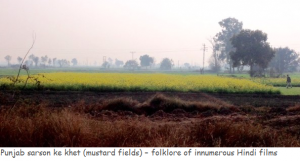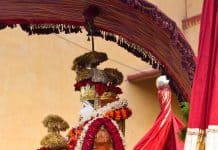A quick way to describe the Land of Five Rivers would be to say Punjab is the Frontier of India and the Land of Plenty from where large-hearted, fearless Aryans of Indian Civilization ascend. There is more to the state than crops, rivers, and places of pilgrimage. Punjabis are the most adventurous and enterprising farmers. Hindi films have often given us glimpses of lush green fields and yellow-flowers of sarson-ke-khet (mustard fields) and the state does warrant a visit from a tourist’s angle. An ancient seat of civilization and power, the state is richly endowed with heritage and history via some of its well-known cities of Chandigarh (a Union Territory that serves as the capital of Punjab and Haryana), Ludhiana, Jalandhar (one of the oldest cities in India), Patiala (an immediate recall of Patiala lassi and salwars), Amritsar (the spiritual and cultural center), Bhatinda (the City of Lakes) and more.
From a touristy viewpoint, Punjab puts forth religious and heritage tourism. If you are an expat Sikh in search of your roots, start from Anandpur Sahib where the Khalsa was born, come down to Fatehpur Sahib, proceed to Mast Maula Sahib, Damdama Sahib and then move upwards to Darbar Sahib in Amritsar. For the non-Sikhs, places of interest would be the Golden Temple, Mansa Devi, Maiserkhana and the Durgiania Mandir.
Chandigarh is one of the most beautifully planned cities with arty leanings displaying influence of the French architect Le Corbusier. Capitol Complex, a UNESCO World Heritage site, houses Punjab and Haryana High Court, Assembly, and Secretariat, besides the monuments of Open Hand, Geometric Hill, and Tower of Shadow.
No visit to this state can be complete without the inclusion of The Golden Temple in Amritsar in the itinerary, the city which is also famous for the Wagah Border and the Jallianwala Bagh massacre. The city has narrow streets and self-appointed colonized units called Katras. Popularly-known as the Golden Temple, it is the shrine of Harminder Sahib that devotees throng to pay respect to. It is a delight to catch a glimpse of the glorious Gurudwara’s reflection in the lake, the Pool of Immortality. A walk around the fringe of the lake, then the marble causeway will find you in front of the Golden Temple. Long queues of men in turbans and salwar-kameez clad Sikhnis wait to view Guru Granth Sahib, the holiest book of the Sikhs. It is mandatory to cover your head lest it amounts to blasphemy. At night, the scriptures are ceremoniously taken and kept in the Akal Takht – an imposing structure in front of the path leading to the Golden Temple. The devout air surrounding this complex extends to the kitchen where vegetarian food is cooked and the Langar feeds more than one lakh pilgrims each day, irrespective of their religion and faith. Apart from the salaried kitchen help, some people volunteer to cook this food. A visit during Diwali promises a marvelous spectacle to behold as the whole temple complex is suffused in the light of lamps, the reason being the celebration of Bandi Chhorh Diwas or Freedom Day for the Sikhs, dating back to the Mughal era. To get a hang of the rustic and local flavor, one can take a detour and visit some of the smaller villages around Amritsar.


Think Punjab and can food be far behind? It is the place of hearty preparations with humble ingredients and unfussy techniques. While in this land of plenty, just throw diet to the winds and try the variety of rotis like the layered laccha paranthas, the famous Amritsari kulchas or stuffed paranthas (potatoes, radish, dal) with loads of ghee. For instance, breakfast for Punjabis is aloo paranthas with a generous amount of desi ghee and a tall glass of lassi or kesar dudh with liberal sprinkling of dry fruits, saffron and malai (cream). For lunch, they binge on makki di roti with dollops of white butter, sarson ka saag (mustard greens) and maa ki daal. Hardcore non-vegetarians, their robust dishes include kukkad (chicken) masala, tangdi kebabs, rann or kadai gosht. Dessert is largely phirni of rice, sugar, and milk preparation, served in earthen bowls.


For those who wish to relive their text book days to recount the famous valor of the Sikhs, a visit during three days in March when the twin towns of Anandpur Sahib and Kiratpur Sahib resound to the battle cries of Nihang warriors, who put up scintillating display of mock battles and skills using traditional weapons, is a must. The festivities of Hola Mohalla symbolize revelry on subduing the aggressor. It is a platform for displaying the combative prowess of Guru’s own army. Hola Mohalla coalesces both the spirit of victory and the gaiety associated spring. The camaraderie and oneness amongst the gathered Sikhs is underscored by the sincerity with which they perform community service (kar seva). Voluntary community kitchens or langars, are set up at Anandpur Sahib. Lohri and Baisakhi are two of the most vibrant and spirited festivals. The movements of the Bhangra dance performed during Baisakhi – the harvest festival, are distinctive of the virility of the Punjab.
The Maharajas of Patiala were not only connoisseurs of gems and cars but also avid builders. Baraderi Gardens, old Moti Bagh, Sheesh Mahal stand testimony to their aesthetic sense. Amritsar’s Khalsa College, dome-shaped Buddhist shrines in Saghol, a mosque inside Nurmahal Serai, Bathinda Fort are some of the heritage tours one can take.
Don’t forget to take back eye-catching mementos of hand-woven chaddars in Bagh or Phulkari – the decorative folk art on scarves and shawls! Sunny mustard fields, robust sprightly Sikhs and Punjabis with a large heart and the quaint village life conjure magic which BECKONS you to move, to discover and to devour the mouth-watering state of the Punjab!
Picture courtesy: Arunima Takiar



















